belt Hyundai Tiburon 2004 Owner's Manual
[x] Cancel search | Manufacturer: HYUNDAI, Model Year: 2004, Model line: Tiburon, Model: Hyundai Tiburon 2004Pages: 224, PDF Size: 18.86 MB
Page 13 of 224

YOUR VEHICLE AT A GLANCE
B255A01GK-AAT
INDICATOR SYMBOLS ON THE INSTRUMENT PANEL
* More detailed explanations of these items will be found beginning on page 1-34.
SRS (Airbag) Service Reminder Indicator (SRI)
Door Ajar Warning Light and Chime
Turn Signal Indicator Lights
High Beam Indicator Light
Low Oil Pressure Warning Light
Parking Brake/Low Brake Fluid Level
Warning Light
Charging System Warning LightTail Gate Open Warning Light
ABS Service Reminder Indicator (SRI) (If installed)
Low Fuel Level Warning Light
Malfunction Indicator LightTraction Control Indicator Light (If installed)
Cruise Indicator (If installed)
Seat Belt Reminder Light and Chime
Page 14 of 224

FEATURES OF YOUR HYUNDAI
1
Fuel Recommendations ................................................ 1-2
Breaking in Your New Hyundai ..................................... 1-3
Keys.............................................................................. 1-3
Door.............................................................................. 1-4
Power Windows ............................................................ 1-8
Seats ............................................................................. 1-9
Seat Belts....................................................................1-14
Child Restraint System...............................................1-19
Supplemental Restraint (AIRBAG) system .................1-25
Instrument Cluster and Indicator Lights ...................... 1-32
Warning and Indicator Lights ......................................1-34
Multi-Function Light Switch.........................................1-41
Windshield Wiper/Washer Switch...............................1-43
Sunroof.......................................................................1-47
Mirror...........................................................................1-51
Hood Release.............................................................1-54
Cruise Control.............................................................1-59
Heating and Cooling Control .......................................1-62
Stereo Sound System.................................................1-79
Audio System..............................................................1-81
Antenna.....................................................................1-1041
Page 17 of 224
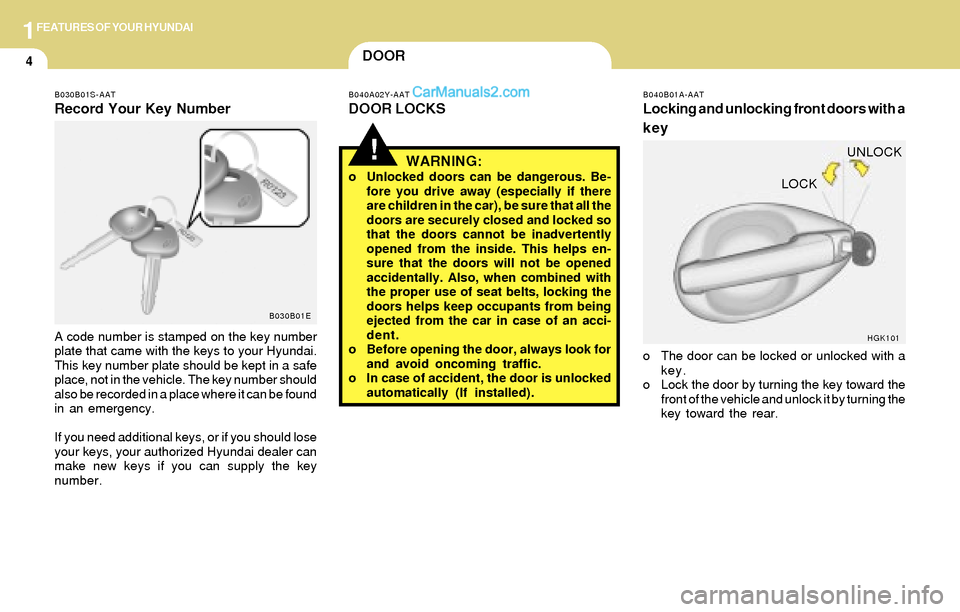
1FEATURES OF YOUR HYUNDAI
4
WARNING:o Unlocked doors can be dangerous. Be-
fore you drive away (especially if there
are children in the car), be sure that all the
doors are securely closed and locked so
that the doors cannot be inadvertently
opened from the inside. This helps en-
sure that the doors will not be opened
accidentally. Also, when combined with
the proper use of seat belts, locking the
doors helps keep occupants from being
ejected from the car in case of an acci-
dent.
o Before opening the door, always look for
and avoid oncoming traffic.
o In case of accident, the door is unlocked
automatically (If installed).
!
DOOR
B030B01S-AAT
Record Your Key Number
A code number is stamped on the key number
plate that came with the keys to your Hyundai.
This key number plate should be kept in a safe
place, not in the vehicle. The key number should
also be recorded in a place where it can be found
in an emergency.
If you need additional keys, or if you should lose
your keys, your authorized Hyundai dealer can
make new keys if you can supply the key
number.
B030B01EB040A02Y-AAT
DOOR LOCKS
B040B01A-AAT
Locking and unlocking front doors with a
key
o The door can be locked or unlocked with a
key.
o Lock the door by turning the key toward the
front of the vehicle and unlock it by turning the
key toward the rear.
HGK101
LOCKUNLOCK
Page 23 of 224
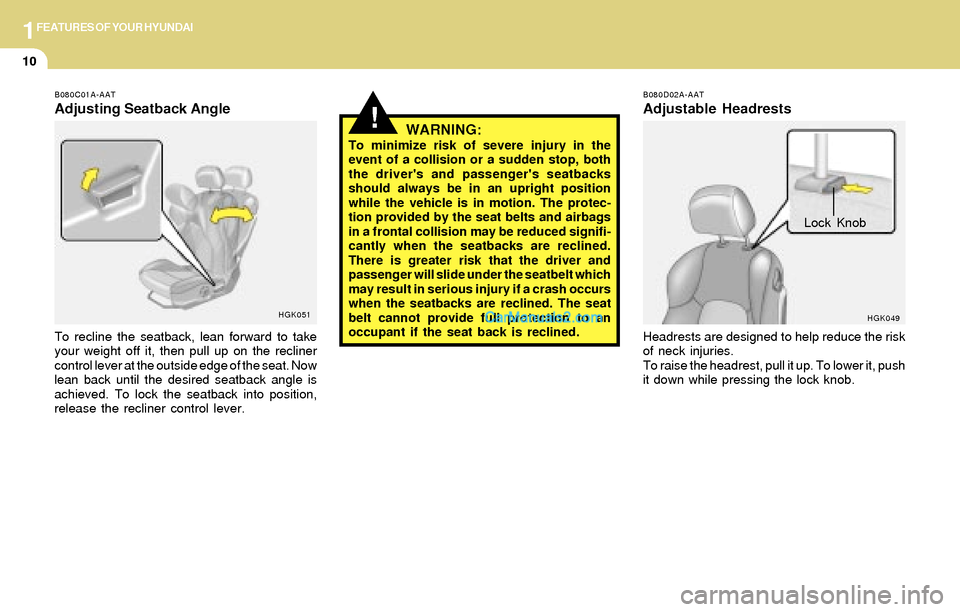
1FEATURES OF YOUR HYUNDAI
10
!WARNING:To minimize risk of severe injury in the
event of a collision or a sudden stop, both
the driver's and passenger's seatbacks
should always be in an upright position
while the vehicle is in motion. The protec-
tion provided by the seat belts and airbags
in a frontal collision may be reduced signifi-
cantly when the seatbacks are reclined.
There is greater risk that the driver and
passenger will slide under the seatbelt which
may result in serious injury if a crash occurs
when the seatbacks are reclined. The seat
belt cannot provide full protection to an
occupant if the seat back is reclined.
B080D02A-AAT
Adjustable Headrests
Headrests are designed to help reduce the risk
of neck injuries.
To raise the headrest, pull it up. To lower it, push
it down while pressing the lock knob.Lock Knob
HGK049
B080C01A-AAT
Adjusting Seatback Angle
To recline the seatback, lean forward to take
your weight off it, then pull up on the recliner
control lever at the outside edge of the seat. Now
lean back until the desired seatback angle is
achieved. To lock the seatback into position,
release the recliner control lever.
HGK051
Page 25 of 224

1FEATURES OF YOUR HYUNDAI
12
!
B130A01GK-AAT
REAR SEAT ENTRY (Walk in device)
The driver and front passenger's seatbacks
should be tilted to enter the rear seat.
By pulling up the walk in device lever (1) at the
left-upper side of the driver side seatback, the
seatback will tilt forward. Then pull the lock
release lever (2) up to move the seat forward.
HGK053
By pulling up the walk in device lever (1) at the
right-upper side of the passenger side seatback,
the seatback will tilt forward. Then push the seat
forward to allow the occupants to enter.
Recliner Memory
By pulling up the walk in device lever (1) the
seatback is reclined and returned to the original
position.
WARNING:Don't drive with the passenger side seatback
reclined. It is dangerous to move it while
driving. Be sure the seatback is caterred
firmly before driving.
HGK240
(1)
(2)(1)
!
B129A01F-AAT
REAR SEAT POSITIONS
WARNING:
This vehicle contains two rear seating po-
sitions only and a seat belt for each seating
position. Thus, never permit more than two
occupants to ride in the rear seat because
an unrestrained occupant could be seri-
ously injured or killed in the event of a
vehicle crash.
B129A01GK
Page 26 of 224
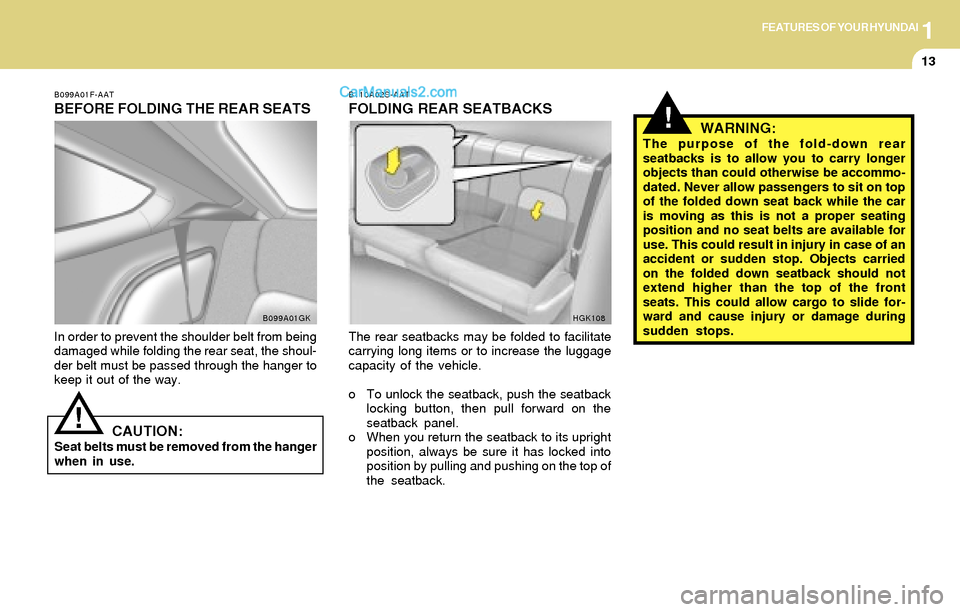
1FEATURES OF YOUR HYUNDAI
13
!
B099A01F-AAT
BEFORE FOLDING THE REAR SEATS
In order to prevent the shoulder belt from being
damaged while folding the rear seat, the shoul-
der belt must be passed through the hanger to
keep it out of the way.
CAUTION:Seat belts must be removed from the hanger
when in use.
!
B099A01GKB110A02S-AAT
FOLDING REAR SEATBACKS
The rear seatbacks may be folded to facilitate
carrying long items or to increase the luggage
capacity of the vehicle.
o To unlock the seatback, push the seatback
locking button, then pull forward on the
seatback panel.
o When you return the seatback to its upright
position, always be sure it has locked into
position by pulling and pushing on the top of
the seatback.
HGK108
WARNING:The purpose of the fold-down rear
seatbacks is to allow you to carry longer
objects than could otherwise be accommo-
dated. Never allow passengers to sit on top
of the folded down seat back while the car
is moving as this is not a proper seating
position and no seat belts are available for
use. This could result in injury in case of an
accident or sudden stop. Objects carried
on the folded down seatback should not
extend higher than the top of the front
seats. This could allow cargo to slide for-
ward and cause injury or damage during
sudden stops.
Page 27 of 224
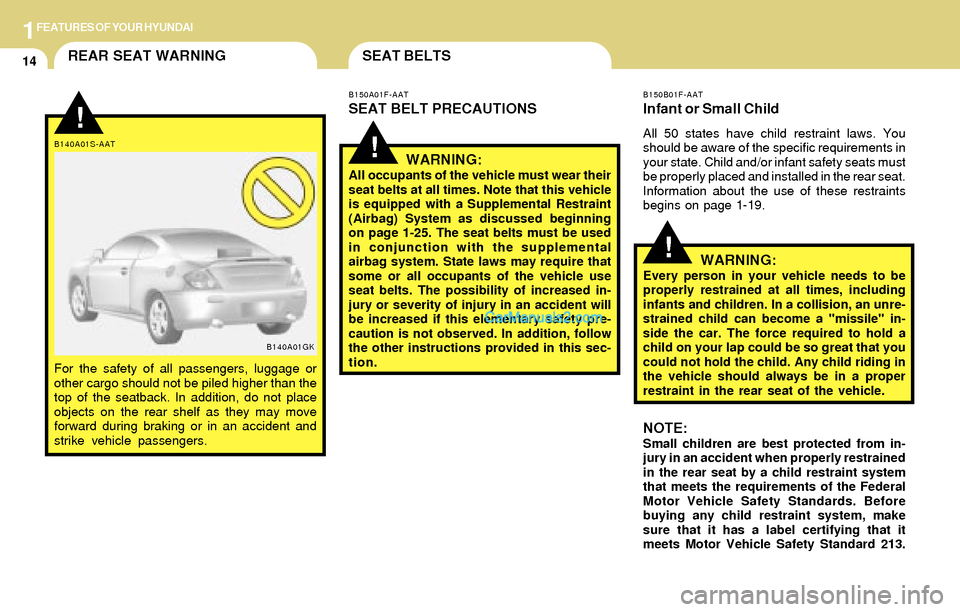
1FEATURES OF YOUR HYUNDAI
14
!
B150B01F-AAT
Infant or Small Child
All 50 states have child restraint laws. You
should be aware of the specific requirements in
your state. Child and/or infant safety seats must
be properly placed and installed in the rear seat.
Information about the use of these restraints
begins on page 1-19.
WARNING:Every person in your vehicle needs to be
properly restrained at all times, including
infants and children. In a collision, an unre-
strained child can become a "missile" in-
side the car. The force required to hold a
child on your lap could be so great that you
could not hold the child. Any child riding in
the vehicle should always be in a proper
restraint in the rear seat of the vehicle.
NOTE:Small children are best protected from in-
jury in an accident when properly restrained
in the rear seat by a child restraint system
that meets the requirements of the Federal
Motor Vehicle Safety Standards. Before
buying any child restraint system, make
sure that it has a label certifying that it
meets Motor Vehicle Safety Standard 213.
!
SEAT BELTS
B150A01F-AAT
SEAT BELT PRECAUTIONS
WARNING:
All occupants of the vehicle must wear their
seat belts at all times. Note that this vehicle
is equipped with a Supplemental Restraint
(Airbag) System as discussed beginning
on page 1-25. The seat belts must be used
in conjunction with the supplemental
airbag system. State laws may require that
some or all occupants of the vehicle use
seat belts. The possibility of increased in-
jury or severity of injury in an accident will
be increased if this elementary safety pre-
caution is not observed. In addition, follow
the other instructions provided in this sec-
tion.
!
REAR SEAT WARNING
B140A01S-AAT
For the safety of all passengers, luggage or
other cargo should not be piled higher than the
top of the seatback. In addition, do not place
objects on the rear shelf as they may move
forward during braking or in an accident and
strike vehicle passengers.
B140A01GK
Page 28 of 224

1FEATURES OF YOUR HYUNDAI
15
!
The restraint must be appropriate for your
child's height and weight. Check the label
on the child restraint for this information.
See page 1-19.
B150C02A-AAT
Larger Children
Children who are too large for child restraint
systems should always occupy the rear seat
and use the available lap/shoulder belts. The lap
portion should be fastened snug on the hips and
as low as possible. Check belt fit periodically. A
child's squirming could put the belt out of posi-
tion. Children are afforded the most safety in the
event of an accident when they are restrained
by a proper restraint system in the rear seat. If
a larger child (over age 13) must be seated in
the front seat, the child should be securely
restrained by the available lap/shoulder belt and
the seat should be placed in the rearmost
position. Children under the age of 13 should be
restrained securely in the rear seat. Never
place a child under the age of 13 in the front seat.
NEVER place a rear facing child seat in the front
seat of a vehicle.
B150D01A-AAT
Pregnant Women
The use of a seat belt is recommended for
pregnant women to lessen the chance of injury
in an accident. When a seat belt is used, the lap
belt portion should be placed as low and snugly
as possible on the hips, not across the abdo-
men. For specific recommendations, consult a
physician.
B150E01A-AATInjured Person
A seat belt should be used when an injured
person is being transported. When this is nec-
essary, you should consult a physician for
recommendations.
B150F01A-AATOne Person Per Belt
Two people (including children) should never
attempt to use a single seat belt. This could
increase the severity of injuries in case of an
accident.
B150G01A-AAT
Do Not Lie Down
To reduce the chance of injuries in the event of
an accident and to achieve maximum effective-
ness of the restraint system, all passengers
should be sitting up and the front seats should
be in an upright position when the car is moving.
A seat belt cannot provide proper protec-tion if
the person is lying down in the rear seat or if the
front seat is in a reclined position.
WARNING:Sitting in a reclined position or lying down
when your vehicle is in motion can be
dangerous. Even if you buckle up, your seat
belts can't do their job when you're re-
clined.
The shoulder belt can't do its job because
it won't be against your body.
Instead, it will be in front of you. In a crash
you could go into it with great force, receiv-
ing serious neck or other injuries.
The lap belt can't do its job either. In a crash
the belt could go up over your abdomen.
The belt forces would be applied there, not
at your strong pelvic bones.
This could cause serious internal injuries.
For proper protection when the vehicle is in
motion, have the seatback upright.
Then sit back in the seat and wear your seat
belt properly. See page 1-17.
Page 29 of 224
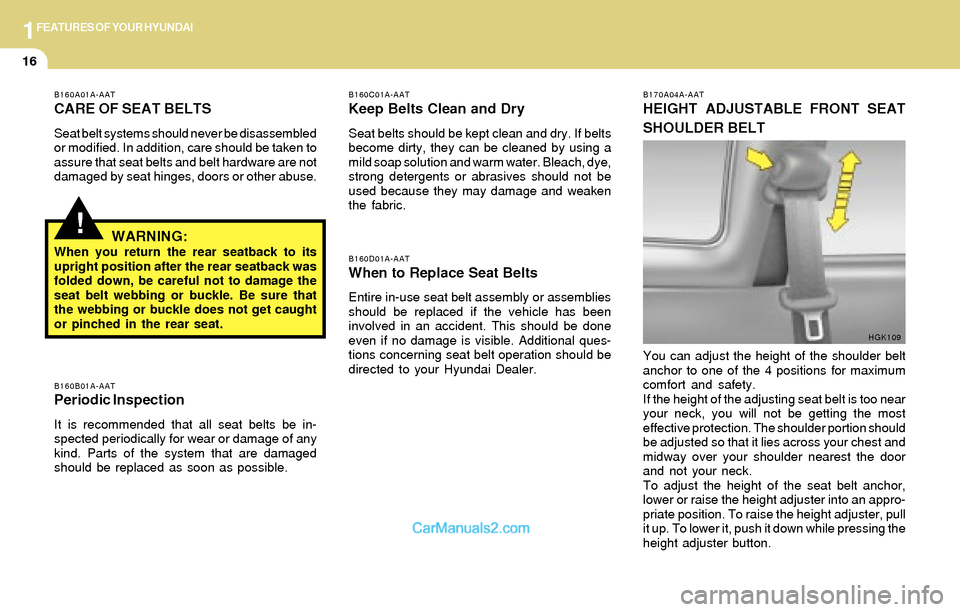
1FEATURES OF YOUR HYUNDAI
16
B170A04A-AAT
HEIGHT ADJUSTABLE FRONT SEAT
SHOULDER BELT
You can adjust the height of the shoulder belt
anchor to one of the 4 positions for maximum
comfort and safety.
If the height of the adjusting seat belt is too near
your neck, you will not be getting the most
effective protection. The shoulder portion should
be adjusted so that it lies across your chest and
midway over your shoulder nearest the door
and not your neck.
To adjust the height of the seat belt anchor,
lower or raise the height adjuster into an appro-
priate position. To raise the height adjuster, pull
it up. To lower it, push it down while pressing the
height adjuster button.
HGK109 B160C01A-AAT
Keep Belts Clean and Dry
Seat belts should be kept clean and dry. If belts
become dirty, they can be cleaned by using a
mild soap solution and warm water. Bleach, dye,
strong detergents or abrasives should not be
used because they may damage and weaken
the fabric.
B160D01A-AATWhen to Replace Seat Belts
Entire in-use seat belt assembly or assemblies
should be replaced if the vehicle has been
involved in an accident. This should be done
even if no damage is visible. Additional ques-
tions concerning seat belt operation should be
directed to your Hyundai Dealer.
!
B160A01A-AAT
CARE OF SEAT BELTS
Seat belt systems should never be disassembled
or modified. In addition, care should be taken to
assure that seat belts and belt hardware are not
damaged by seat hinges, doors or other abuse.
WARNING:When you return the rear seatback to its
upright position after the rear seatback was
folded down, be careful not to damage the
seat belt webbing or buckle. Be sure that
the webbing or buckle does not get caught
or pinched in the rear seat.
B160B01A-AATPeriodic Inspection
It is recommended that all seat belts be in-
spected periodically for wear or damage of any
kind. Parts of the system that are damaged
should be replaced as soon as possible.
Page 30 of 224
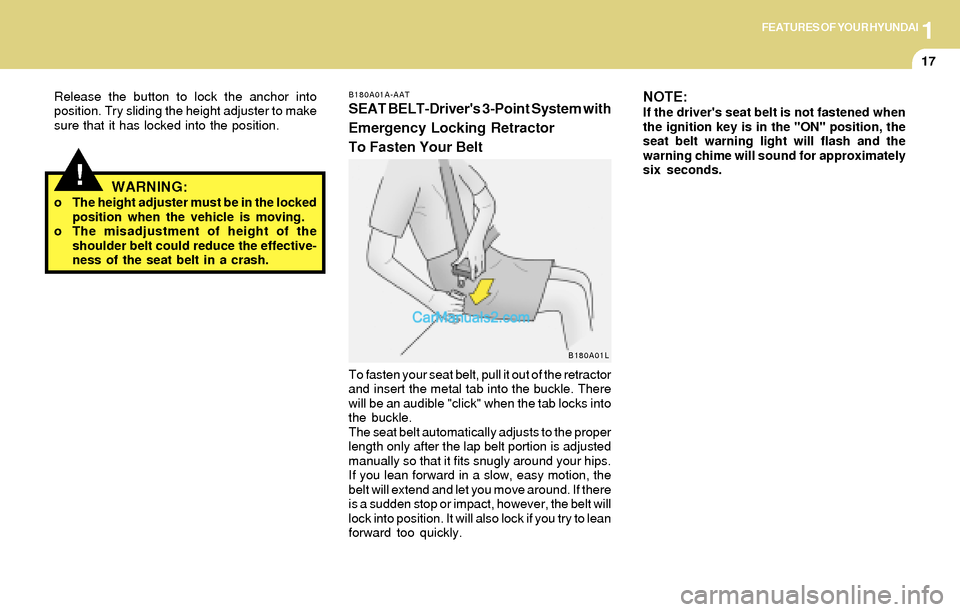
1FEATURES OF YOUR HYUNDAI
17
!
Release the button to lock the anchor into
position. Try sliding the height adjuster to make
sure that it has locked into the position.
WARNING:o The height adjuster must be in the locked
position when the vehicle is moving.
o The misadjustment of height of the
shoulder belt could reduce the effective-
ness of the seat belt in a crash.
B180A01A-AAT
SEAT BELT-Driver's 3-Point System with
Emergency Locking Retractor
To Fasten Your Belt
To fasten your seat belt, pull it out of the retractor
and insert the metal tab into the buckle. There
will be an audible "click" when the tab locks into
the buckle.
The seat belt automatically adjusts to the proper
length only after the lap belt portion is adjusted
manually so that it fits snugly around your hips.
If you lean forward in a slow, easy motion, the
belt will extend and let you move around. If there
is a sudden stop or impact, however, the belt will
lock into position. It will also lock if you try to lean
forward too quickly.
B180A01L
NOTE:If the driver's seat belt is not fastened when
the ignition key is in the "ON" position, the
seat belt warning light will flash and the
warning chime will sound for approximately
six seconds.